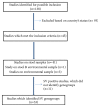Prevalence of Human Sapovirus in Low and Middle Income Countries
- PMID: 30245718
- PMCID: PMC6139206
- DOI: 10.1155/2018/5986549
Prevalence of Human Sapovirus in Low and Middle Income Countries
Abstract
Background: Sapovirus (SV) infection is a public health concern which plays an important role in the burden of diarrhoeal diseases, causing acute gastroenteritis in people of all ages in both outbreaks and sporadic cases worldwide.
Objective/study design: The purpose of this report is to summarise the available data on the detection of human SV in low and middle income countries. A systematic search on PubMed and ScienceDirect database for SV studies published between 2004 and 2017 in low and middle income countries was done. Studies of SV in stool and water samples were part of the inclusion criteria.
Results: From 19 low and middle income countries, 45 published studies were identified. The prevalence rate for SV was 6.5%. A significant difference (P=0) in SV prevalent rate was observed between low income and middle income countries. Thirty-three (78.6%) of the studies reported on children and 8 (19%) studies reported on all age groups with diarrhoea. The majority (66.7%) of studies reported on hospitalised patients with acute gastroenteritis. Sapovirus GI was shown as the dominant genogroup, followed by SV-GII.
Conclusion: The detection of human SV in low and middle income countries is evident; however the reports on its prevalence are limited. There is therefore a need for systematic surveillance of the circulation of SV, and their role in diarrhoeal disease and outbreaks, especially in low and middle income countries.
Figures
Similar articles
-
Prevalence and Genetic Characterisation of Human Sapovirus from Children with Diarrhoea in the Rural Areas of Vhembe District, South Africa, 2017-2020.Viruses. 2021 Mar 1;13(3):393. doi: 10.3390/v13030393. Viruses. 2021. PMID: 33804579 Free PMC article.
-
Genetic diversity of norovirus, sapovirus, and astrovirus isolated from children hospitalized with acute gastroenteritis in Chiang Mai, Thailand.J Med Virol. 2008 Oct;80(10):1749-55. doi: 10.1002/jmv.21244. J Med Virol. 2008. PMID: 18712816
-
Molecular detection and characterisation of sapoviruses and noroviruses in outpatient children with diarrhoea in Northwest Ethiopia.Epidemiol Infect. 2019 Jan;147:e218. doi: 10.1017/S0950268819001031. Epidemiol Infect. 2019. PMID: 31364546 Free PMC article.
-
Norovirus Gastroenteritis Outbreaks, Genomic Diversity and Evolution: An Overview.Mymensingh Med J. 2021 Jul;30(3):863-873. Mymensingh Med J. 2021. PMID: 34226482 Review.
-
Norovirus Infections and Disease in Lower-MiddleandLow-Income Countries, 1997⁻2018.Viruses. 2019 Apr 10;11(4):341. doi: 10.3390/v11040341. Viruses. 2019. PMID: 30974898 Free PMC article. Review.
Cited by
-
Genetic Diversity of Sapoviruses among Inpatients in Germany, 2008-2018.Viruses. 2019 Aug 7;11(8):726. doi: 10.3390/v11080726. Viruses. 2019. PMID: 31394867 Free PMC article.
-
Genotypes Diversity of Acute Gastroenteritis Outbreaks Caused by Human Sapovirus - Beijing Municipality, China, 2015-2021.China CDC Wkly. 2023 Jul 14;5(28):625-631. doi: 10.46234/ccdcw2023.119. China CDC Wkly. 2023. PMID: 37520444 Free PMC article.
-
Caliciviridae Other Than Noroviruses.Viruses. 2019 Mar 21;11(3):286. doi: 10.3390/v11030286. Viruses. 2019. PMID: 30901945 Free PMC article. Review.
-
Viral metagenomics reveals sapoviruses of different genogroups in stool samples from children with acute gastroenteritis in Jiangsu, China.Arch Virol. 2020 Apr;165(4):955-958. doi: 10.1007/s00705-020-04549-y. Epub 2020 Feb 11. Arch Virol. 2020. PMID: 32048042 Free PMC article.
-
The outbreak of acute gastroenteritis caused by sapovirus at a school in Shenzhen, China, 2023.Front Public Health. 2025 May 9;13:1572482. doi: 10.3389/fpubh.2025.1572482. eCollection 2025. Front Public Health. 2025. PMID: 40416694 Free PMC article.
References
-
- Govender T., Barnes J. M., Pieper C. H. Contribution of water pollution from inadequate sanitation and housing quality to diarrheal disease in low-cost housing settlements of Cape Town, South Africa. American Journal of Public Health. 2011;101(7):p. -e9. doi: 10.2105/AJPH.2010.300107. - DOI - PMC - PubMed
Publication types
LinkOut - more resources
Full Text Sources
Other Literature Sources


